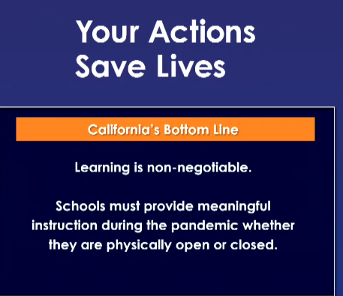Orange County schools, along with campuses in 32 other counties on California’s COVID-19 watch list, can expect to start the year with distance learning rather than in-person instruction or hybrid models, Gov. Gavin Newsom announced Friday.
Speaking during a highly anticipated afternoon briefing, Newsom issued sweeping new directives for public and private schools, spanning distance learning, face coverings — they will be required for staff and students in grades three and up — coronavirus testing for staff, and how to reopen and close schools in the event of an outbreak.
“The governor has made it clear what will need to happen to resume in-person learning, as well as the steps we must take to keep our students, staff and families safe when we do come back together,” Orange County Superintendent Al Mijares said afterward.
“Our department will do everything in its power to support robust distancing learning in Orange County,” Mijares added. “At the same time, we must also unite as a community and do our part to reduce transmission of this dangerous virus, including social distancing and wearing face coverings in public.”

The California Department of Public Health’s industry guidance for schools and school-based programs, on which OCDE has based its own recommendations, was also updated Friday to reflect the governor’s new mandates.
Counties must bring down counts
Orange County, home to 28,309 COVID-19 cases since the outbreak began, is one of 33 counties on the state’s monitoring list based on transmission rates, hospitalizations and hospital capacities.
The governor’s order says schools in these counties cannot physically re-open for in-person instruction until their county is off that list for 14 consecutive days, placing the onus on county leaders and residents to bring their rates down.
A waiver provision could allow some elementary campuses in impacted counties to offer in-person instruction if they work with local stakeholders and get permission from their county health officers and the state public health department, which is expected to release more information.
Meanwhile, a number of local districts, including those serving Santa Ana and Anaheim students, had already announced plans to start the year with distance learning to slow the spread of the coronavirus in their communities.
“Our students, our teachers, staff and certainly parents, we all prefer in-classroom instruction for all the obvious reasons,” Newsom said, “but only if it can be done safely.”
Face coverings now required
When in-person learning continues, he said, adults will be required to wear face coverings and maintain 6 feet of distance with other adults, and they’ll be encouraged to do the same with children when possible. For teachers in lower grades, face shields are recommended.
Students in grades three through 12 will be required to wear face coverings and social distancing is encouraged to the extent possible. Face coverings are strongly encouraged for young children between two years old and second grade, if they can be worn properly. A face shield is an acceptable alternative for children in this cohort who cannot wear masks properly.
Staff at every California school should be tested regularly based on local disease trends and as testing capacity allows. Newsom said the state will provide resources and technical assistance for COVID-19 investigations in school settings.
When to close a school or district
Newsom also outlined circumstances under which a classroom, school or district would have to close. Working with county public health officials, district officials should shutter a classroom if a student or teacher has tested positive for COVID-19. They should close a school if it reaches a 5 percent COVID-19 positivity rate. And districts should pivot back to distance learning when 25 percent of their campuses have closed.
The governor said $5.3 billion in federal funds should be used by districts to address equitable access to remote learning.
“Learning in the state of California is simply non-negotiable,” he said. “Schools must provide meaningful instruction during this pandemic whether they are physically opened — the schools — or not.”
